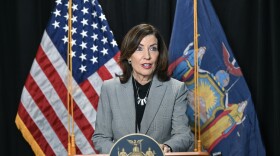Onondaga Lake was once the most polluted lake in the nation, now it’s an example of the power of conservation efforts. Learning from the past has helped to restore the habitat.
Walking along the trail at Onondaga Lake Park’s West Branch Trail on any summer evening, you’ll be met with cyclists, walkers, families and even a dog or two.
But that has not always been the case, Onondaga County’s investment and development into the walking trails surrounding Onondaga Lake, including the “Loop-the-Lake” project have made the most significant development over the past two decades. And what is now a fun, recreational destination really sits over the site of a significant historical and cultural location.
Onondaga Lake is both the birthplace of the first Western representative democracy and an example of how industrialization can impact the environment. But for many Central New Yorkers, there is only one association with Onondaga Lake: pollution. Chris Lajewski, President of the Onondaga Lake Conservation Corps said many people remember the lake as the most polluted lake in the nation.
“Many community members have lived here for their entire lifetime,” Lajewski said. “Maybe it was 50, 60, 70 years or longer. And they recall a time when you just you didn't go to Onondaga Lake. It was a very polluted lake. It was the most polluted lake in the country. And that is not a stretch to stay.”
How did it get that way? About a century of industrial chemical dumping into the lake. The New York State Department of Environmental Conservation said beginning in the 1880s several industries surrounding the lake, namely Honeywell’s predecessor AlliedSignal, dumped waste including “mercury, salt processing residue, ammonia, organic compounds and PCBs” directly into the water. By the 1940s, swimming was banned, and in 1970, fishing too.
The lake was toxic – and a sacred place had been destroyed. In Haudenosaunee history, Onondaga Lake is where the Peacemaker brought the Seneca, Cayuga, Onondaga, Oneida, and Mohawk Nations together to form the Haudenosaunee Confederacy. Phillip Arnold, founding member of the Skä·noñh—Great Law of Peace Center, which focuses on telling the story of the native peoples of Central New York, said that the lake remains a sacred place.
“Not many people know they were out of Onondaga Lake came Western Democracy or women's or lacrosse or these other kinds of real important elements,” Arnold said.
He said prior to the pollution, the lake was a destination for game, medicines and fishing. Sandra Bigtree, a citizen of the Mohawk Nation, grew up in Syracuse. She said the polluted water has a real impact on the relationship between people and the land.
“I guess we kind of think it's really hard to have a proper relationship when the water itself can kill you because it's been polluted and abused,” Bigtree said “But, but they still, you know, it's still a sacred lake. It has potential to regenerate, you know, if it's dealt with properly.”
That potential to regenerate keeps hope for the conservation efforts. Arnold said the Onondaga Nation will continue to advocate for restoration.
“I've heard like one Onondaga person say it's like the lake is our relative, and even though our relative is sick, you don't give up on your relative,” Arnold said. “So they're always advocating for the full restoration of the lake.”
And some progress has been made, but not without challenges. In 2006, Honeywell reached an agreement with the state DEC for a $451 million clean up plan. And in 2017 the Departments of Justice and the Interior, state DEC and state Attorney General’s office reached a $26 million settlement with Honeywell and Onondaga County to implement and maintain restoration projects around the lake.
The Onondaga Lake Conservation Corps, which was founded in 2012 by Honeywell, led by Chris Lajewski, is continuing work on restoring and conserving the environment. He said restoration efforts have not been made in vain.
“People still have questions about the lake,” Lajewski said. “Is it really cleaner? How do we know it's cleaner? Well, you know, one simple way of saying it is that all these 200 plus species of birds, 60 species of fish now reside in the lake and they wouldn't all be there if it wasn't a healthier, cleaner ecosystem.”
One of the most impressive results of the habitat redevelopment and restoration work is the bald eagle nesting and roosting population, which has grown significantly over the past few years.
“So we hoped that would happen eventually,” Lajewski said. “And well, just a few years ago, bald eagles started nesting at the lake and they've nested there ever since. So that's a great sign, you know, that the lake is back and it's a much healthier ecosystem now.”
The Onondaga Lake Conservation Corps’ volunteer and education efforts are looking toward the future as well. Lajewski said maintaining and continuing to improve the ecosystem will need conservationists of all ages.
“So we've really long term maintenance monitoring of these ecosystems is critical and Audubon's going to be involved in that and we are involving our young people in our next generation of conservationists program, next gen, we refer to it as works with middle school and high school students and provides them with opportunities to build their skills,” Lajewski said.
Despite significant improvements, and the lake being the cleanest it has been in the last 100 years, swimming is still not allowed and the mercury levels in the fish species make them unsuitable to eat. Bigtree said restoring the lake and healing the relationship for future generations needs to remain a top priority.
“There's going to be future generations, and it's going to be horrible if everybody doesn't start understanding what indigenous people have been trying to communicate since first contact,” Bigtree said.








